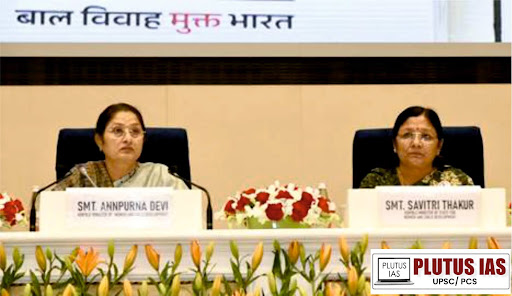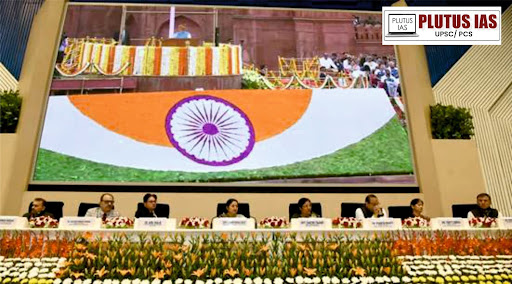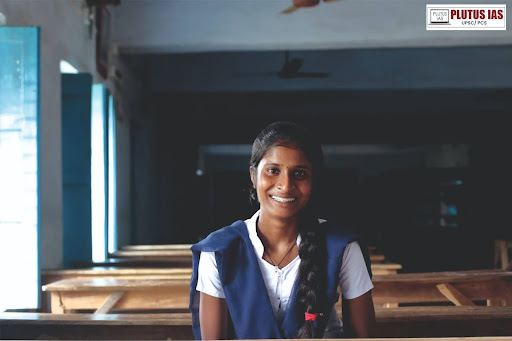02 Dec Breaking the Chains: Ending Child Marriage in India
This article covers “Daily Current Affairs” and topic details of Breaking the Chains: Ending Child Marriage in India
Syllabus mapping:
GS-2: Social Justice: Vulnerable sections and policies related to empowering the vulnerable sections.
GS-1: Indian Society: women and women’s associated issues.
For Prelims:
The Child Marriage Act 2006, its provisions and definitions. What are the various policies of the Government of India to eliminate Child marriages in India?
For Mains:
Current trends in India regarding child marriages, their causes and impacts. Ways and measures to eliminate child marriages in India.
Why in the news?
The Union Minister for Women and Child Development, Smt. Annapurna Devi, recently launched the ‘Bal Vivah Mukt Bharat’ (Child Marriage Free India) campaign, marking a significant step toward eradicating child marriage and empowering young girls across the nation. As part of the initiative, a dedicated Child Marriage Free Bharat Portal was introduced to monitor and support efforts against child marriage. The event also included a nationwide pledge to combat this social issue and raise awareness about its harmful effects. This mission reflects the government’s strong commitment to ensuring the safety, education, and well-being of every child in India.

Child Marriage Trends in India
1. Overall Decline in Child Marriage: The prevalence of child marriage reduced from 47.4% in 2005–06 to 26.8% in 2015–16, registering a sharp decline of 21 percentage points in a decade. Between 2015–16 and 2019–21, child marriage further declined by 3.5 percentage points, reaching 23.3%.
2. Age at Marriage: The median age of first marriage for women (aged 20–49) increased from 17.2 years in 2005–06 to 19.2 years in 2019–21. For men (aged 25–29), the median age rose from 22.6 years to 24.9 years during the same period.
3. Trends Among Younger Women: Among women aged 18–19 years, the prevalence of child marriage declined from 37.7% in 2005–06 to 16.3% in 2019–21, indicating a continued downward trend.
4. Socio-Economic and Educational Differentials
Education: 48% of girls with no education were married before 18, compared to only 4% of girls with higher education. Each additional year of education increases the age at marriage by 0.36 years.
Economic Status: 40% of girls from the lowest wealth quintile were married before 18, while only 8% from the highest quintile faced the same fate.
Caste and Religion: Higher prevalence among Scheduled Castes (SC) and Scheduled Tribes (ST) (26%), though the gap is narrowing. Lower rates among Christians, Muslims, and other minority religious groups compared to Hindus.
5. State-Wise Variations: West Bengal, Bihar, and Tripura (over 40% of women aged 20–24 married before 18). Other states with a high prevalence of child marriages include Jharkhand, Assam, Andhra Pradesh, Rajasthan, and Telangana.
6. Predictive Indicators: Girls with lower education levels are 15.5 times more likely to marry before 18. Women from the poorest wealth quintile have 1.5 times higher odds of child marriage compared to the richest quintile. Rural residents and certain caste groups, such as Scheduled Tribes, face higher odds of child marriage.
Government Initiatives to Reduce Child Marriages in India
Prohibition of Child Marriage Act, 2006: Strictly prohibits marriages involving girls below 18 years and boys below 21 years. Imposes severe penalties on violators and provides a legal framework to prevent and address cases of child marriage.
Sukanya Samriddhi Yojana: Encourage families to save for their daughters’ education and future, reducing economic pressures that often lead to early marriages.
Child Marriage Free Bharat Campaign: Raise awareness, empower communities, and create a supportive ecosystem to eliminate child marriages.
Beti Bachao Beti Padhao (BBBP) Scheme: The Beti Bachao Beti Padhao (BBBP) scheme is a comprehensive initiative aimed at promoting gender equality, empowering girls, and tackling the issue of child marriage.
CHILDLINE (1098): It is the service that coordinates with local authorities, such as the police, Child Marriage Prohibition Officers (CMPOs), and District Child Protection Units (DCPU), to respond swiftly and effectively to child marriage cases.
National Commission for Protection of Child Rights (NCPCR): The National Commission for Protection of Child Rights (NCPCR) plays an essential role in addressing the issue of child marriage through collaboration and advocacy.
Child Welfare Committees (CWC): They consist of representatives from the police, civil society organizations, and government agencies. They conduct awareness campaigns and encourage States/UTs to implement preventive actions, particularly during important cultural events like Akshay Tritiya.
Awareness Campaigns and Media Outreach: The government conducts regular awareness campaigns, media outreach, and community programs to inform the public about the dangers of child marriage and promote social change.
Stakeholder Collaboration and State-Level Coordination: To effectively combat child marriages, the government works in close collaboration with local governments, civil society organizations, and community leaders.

Causes of Child Marriages
1. Poverty
Economic Pressure: Poverty-stricken families marry off daughters early to reduce financial burdens or gain monetary benefits through dowries.
Mass Marriages: Economically weaker families organize mass marriages to minimize expenses, often resulting in child marriages.
Trafficking Risks: Some families, knowingly or unknowingly, marry off young daughters in exchange for money, leading to trafficking and exploitation.
2. Dowry System: The customary dowry practice compels families to marry daughters at a younger age, as younger brides often require lower dowries.
3. Patriarchy: Power Imbalance: Deeply entrenched patriarchal norms deprive women of decision-making rights, including their marriage. Male Domination: Marriage decisions, including timing and spouse selection, are often made by fathers or male elders, sidelining women’s autonomy.
4. Sexuality and Virginity Concerns
Family Honor: The emphasis on preserving virginity and family honor prompts parents to marry daughters early.
Protection from Advances: Early marriage is seen as a safeguard against “improper” behavior or unwanted sexual advances.
Burden on Parents: Parents view daughters as a “burden” to be relieved through early marriage.
5. Cultural and Social Myths: Beliefs such as attaining salvation through early marriage or curing diseases (like AIDS) through intercourse with virgins perpetuate the practice.
6. Caste Hierarchy: Preservation of Caste: Child marriage ensures that individuals marry within their caste to uphold hereditary caste norms and avoid inter-caste unions.
Impacts of Child Marriages
Reproductive and Sexual Health Risks: Child brides face high rates of obstetric complications, such as pregnancy-induced hypertension and premature delivery. They are more likely to experience fetal wastage (miscarriages or stillbirths) and higher rates of maternal and infant mortality.
Maternal Mortality and Morbidity: Adolescent mothers are at double the risk of dying due to pregnancy-related complications. Frequent pregnancies, malnutrition, and lack of proper healthcare contribute to a high maternal mortality rate.
Infant Mortality and Morbidity: Infants born to adolescent mothers have a higher risk of premature birth, low birth weight, and poor growth. The Infant Mortality Rate (IMR) is significantly higher for adolescent mothers compared to adult mothers.
Limited Family Planning and Contraceptive Use: Contraceptive use is very low among adolescent mothers, leading to frequent pregnancies and related complications. Many young women face unmet contraceptive needs, resulting in unplanned pregnancies and unsafe abortions.
Lesser Autonomy for Girls: Child brides have less control over health, household decisions, and financial matters. They face restrictions on mobility and decision-making, impacting their ability to access healthcare and education.
Lack of Exposure and Information: Child brides are often isolated and lack access to important information about reproductive health and contraception. Many are not exposed to any form of media, further limiting their awareness of rights and available support.
Increased Susceptibility to Gender-Based Violence: Child brides are more likely to experience physical or sexual abuse. A significant number of young women justify abuse, and many are exposed to violence in their marriages.
Sexual Exploitation and Abuse: Early marriage exposes girls to sexual exploitation and abuse by their husbands and others in their marital homes. Child brides face increased health risks, including trauma from early sexual activity, pregnancy, and childbirth.
Child Trafficking: Child marriage is linked to trafficking, where young girls are sold or trafficked for sexual exploitation or bonded labor. In some regions, girls are married off young and then trafficked to other areas for forced prostitution or labor.
Social and Economic Disadvantages: Child marriages restrict girls’ opportunities for education and economic independence. They are more likely to experience poverty, limited opportunities, and social exclusion throughout their lives.
Effective Ways to End Child Marriage in India:
Empower Girls with Education: Education empowers girls to break the cycle of child marriage. By providing access to quality education, girls gain the skills and confidence to make informed choices about their futures.
Promote Gender Equality: Achieving gender equality is key to ending child marriage. Challenging harmful gender norms and stereotypes helps create a society where girls are valued equally to boys.
Encourage Supportive Laws and Child Protection Policies: Strong legal frameworks and child protection policies are vital. Advocating for and enforcing laws against child marriage ensures that children’s rights are upheld in practice.
Educate and Spread Awareness About Child Marriage: Awareness campaigns are essential to bring about change. Educating communities about the harmful effects of child marriage can encourage them to reject this practice.
Support the Development of Adolescent Girls: Focusing on the physical and emotional well-being of adolescent girls helps prevent child marriage. Programs aimed at their overall development equip them to make independent decisions.
Educate Parents About Child Marriage: Parents are often the decision-makers in child marriages. Workshops and awareness sessions for parents highlight the detrimental long-term effects of early marriage on their daughters.
Report Child Marriages: Community involvement is crucial in preventing child marriage. Reporting any incidents of child marriage ensures that authorities can intervene and take immediate action.
Refuse Participation in Events Promoting Child Marriage: It is important to stand against child marriage by refusing to take part in events that promote or support it. Every individual action counts towards eradicating this harmful practice.
Collaborate with NGOs to Prevent Child Marriage: NGOs play a vital role in preventing child marriage by providing resources, support, and guidance. Collaborating with such organizations strengthens efforts to create a safer environment for children.
Proactive Role of the Government: The government must enforce laws against child marriage, monitor age requirements, and conduct awareness campaigns. Programs like “Beti Bachao Beti Padhao” have been successful in raising awareness at the grassroots level.

Conclusion:
Child marriage is not only a barrier to a girl’s dreams and aspirations but also a violation of fundamental human rights and constitutional principles. It is a crime against both the individual and society, hindering progress and development. In a progressing society like India, it is essential to eliminate child marriage, as it deprives girls of their right to education, health, and empowerment. By ending this harmful practice, we can allow girls to reach their true economic, political, and social potential, contributing to the advancement of the nation as a whole.
Download Plutus IAS Current Affairs ENG MED 02nd Dec 2024 pdf
Prelims question
Q. With reference to the legislation related to child marriages in India, consider the following statements:
1. Har Bilas Sarda is best known for the introduction of the Child Marriage Restraint Act (1929).
2. The Prohibition of Child Marriage Act, of 2006, allows for the nullification of child marriages and mandates the return of all valuables if a marriage is voided.
3. The Prohibition of Child Marriage (Amendment) Bill, 2021, seeks to equalize the marriage age for men and women by raising it to 21 years.
How many of the above statements are correct?
A. Only one
B. Only two
C. All three
D. None
ANSWER: C
Mains question:
Assess the effectiveness of civil society organizations and charitable trusts in addressing the issue of child marriage in India. How do their interventions complement government efforts?
(Answer in 250 words)




No Comments